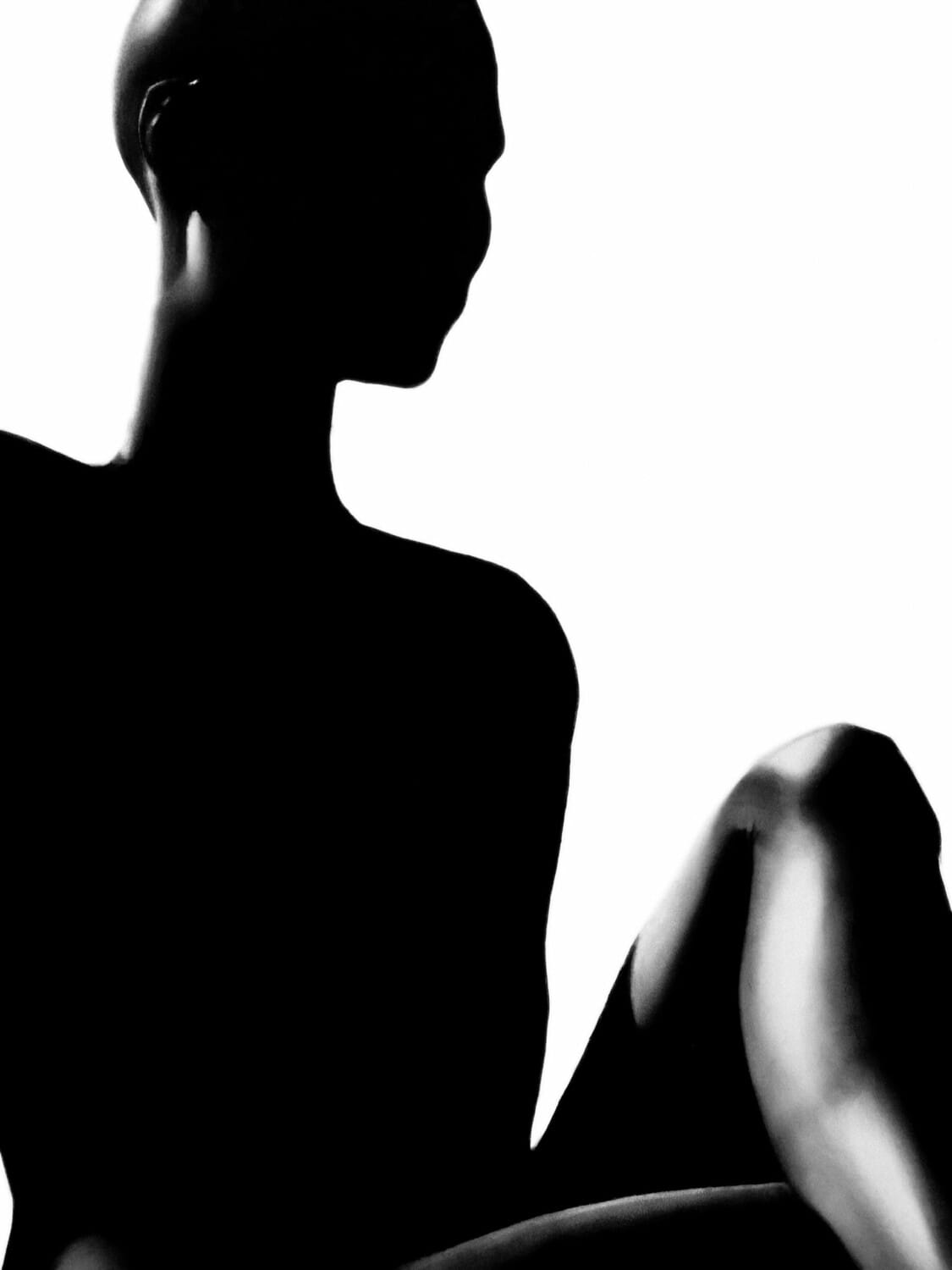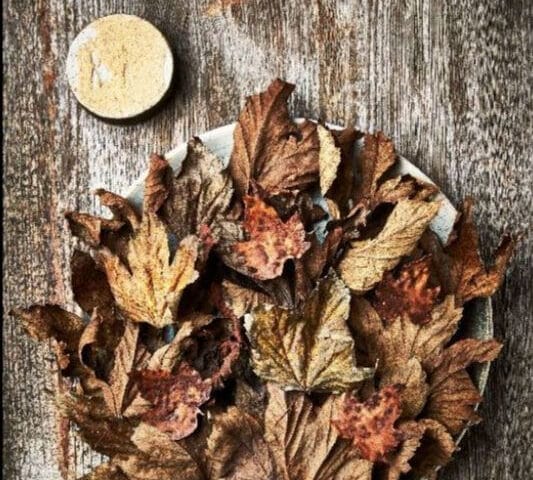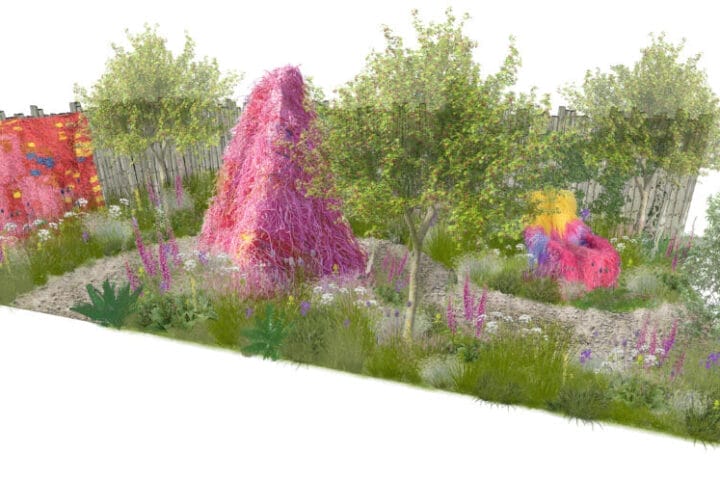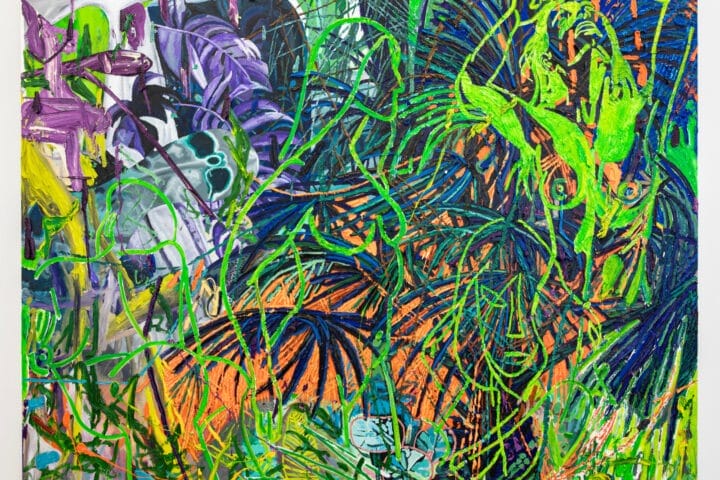Presenting over 60 works from 9 international artists, the show encompasses painting, mixed media on canvas, works on paper, collage, three dimensional sculpture and textiles, from Juwon Aderemi (Nigeria), Luke Agada (Nigeria), Chiderah Bosah (Nigeria), Patrick Eugène (United States), Gustavo Nazareno (Brazil), Oliver Okolo (Nigeria), Oginjiri Peter (Nigeria), Adjei Tawiah (Ghana) and Musah Yussif (Ghana).
Responding to a year of individual and collective critical evaluations of universal humanity, particularly with regards to race, the artists on show – each from disparate backgrounds – reflect on representations of Blackness. Transgressing perceived artistic boundaries, from traditional African abstraction and figuration, to spiritual expressionism, indigenous ritual, sacred practices and cultural retention, they disrupt the Western arts canon, whilst celebrating Africa’s undeniable contribution to it – with particular reference to the movements of surrealism, mannerism and portraiture.

In Collective Reflections, the artists recreate their own hierarchies of interest, from allegorical themes delving into psychological introspection, to the self-affirming expressions of beauty and adornment. Reframing traditional signifiers of class, gender, ethnicity and status, the artists collectively represent a new international vanguard redefining the global artistic landscape.
Curator, and a mentor to the artists, Danny Dunson says “In the midst of devastating challenges of the global pandemic, political discord, and the ongoing fight against systemic racism and oppression, a reflective meditation and organic visual dialogue transpired between nine artists living and practicing in West Africa, and the Americas. While grappling within the stillness of quarantine, and the disquieting of global insurrection, these artists were compelled to examine their humanity, forming a collective journey between artists who, before this moment, had never met.”
Drawing inspiration from contemporary artists Yinka Shonibare and Kerry James Marshall, alongside surrealist painters Salvador Dali and René Magritte, Nigerian artist Luke Agada presents The Kindred Project, a body of paintings and mixed media sculptures addressing interpersonal connections that exist amongst the transglobal Black community, through Ghanaian Adinkra symbols. Chiderah Bosah presents Grey, a new body of self-portraits that contemplate and grapple with the daily life of a young Nigerian man, a triumphant personal response to the END SARS movement and consequent violence in the country.
Meanwhile artist Oliver Okolo presents Portraits of the Life Elizabeth Freeman, a body of work centering on the abolitionist figurehead and neglected social discourses. The artist expresses “I felt compelled by Freeman and her story during this critical time when Black people around the world are embracing our brothers and sisters in the U.S. I’ve been more aware of my own oppression through colonialism and the horrible loss Africa has endured from the Middle Passage and enslavement of the Diaspora”.
The son of Haitian immigrants, Patrick Eugène incorporates African Diasporic connections between Haiti (the Caribbean), and North America within an intuitive practice that connects him to everyday people in the streets of Atlanta, Georgia. Photographs taken by the artist are later transposed into portraits that deviate from naturalism, to evoke the abstractionism of ancient Africa and the vibrant color palettes of Haiti. ?
Self-taught Nigerian artist Oginjiri Oluwaseun Peter renders the naturalistic features of his subjects within traditional ritualistic masks, focusing on expression beyond the materiality of skin and skin color. Referring to colonial Africa, the artist explains “this series borrows from historical aesthetics of a precolonial past, to narrate hope from a future stronger sense of self.”
Inspired by the nightmarish visions of Francisco Goya, though infusing them with geometric abstractions found in Islamic art, Musah Yussif’s work analyses personal fears and concerns. The works on show acknowledge the inherent fragility of the human condition as somewhere between a beautiful dream and a horrific nightmare.
Brazilian artist Gustavo Nazareno presents recent charcoal works on paper based on the origins of Exú (Yoruba: also spelled, Eshu, È?ù, and Echú), a shape-shifting god of multidimensionality, traversing gender, age, and animal forms. Created whilst in a prayerful, meditative state the works appear like high fashion photography, but are hand drawn by the artist’s fingertips applying charcoal dust to paper, in a dark studio lit by only candlelight.
Juwon Aderemi’s works explore intellectual discourses in Blackness and West African folklore and literature. His studies combine vintage photographic imagery of 1970-80s Nigeria in multimedia compositions on canvas and corresponding three-dimensional works in textile design. Aderemi ponders the simplicity of the human condition, a longing to incorporate more of the ancient past with modernity, through the lens of traditional and contemporary Nigerian notions of gender, beautification, and adornment.
Ghanaian artist Adjei Tawiah presents works utilizing his self-titled ‘sponge martial’ technique. Inspired by the experience of watching his mother’s body being cleansed in a mortuary and used also as a figurative cleansing of negative thought processes in minds more generally, he creates brightly colored yet delicately textured portraits across mixed media.
About the artists
Luke Agada (b.1992) is a licensed veterinarian who recently professionally committed full time to his intuitive art practice. Leveraging his scientific discipline to make acute compositions informed in a dialectical response to Surrealist and Afro-Futurists art movements, the artist’s mixed media sculptures connect symbology, iconography, and lyricism to thoughts of nostalgia, unification, and cultural and self-affirmation.
Agada is a consummate scholar of art, and history, and is inspired by African American history, the writings of American sociologist, Mark Granovetter, contemporary artists such as Yinka Shonibare, and Kerry James Marshall, as well as historical canonical artists, Salvador Dali and René Magritte .
Juwon Aderemi (b.2000) works in an intuitive practice, primarily based in portraiture, privileging his Nigerian, Yoroba culture, while centralizing affirming imagery that seeks to look inward rather than externally, for validation, status, and value. In a study that combines vintage photographic imagery of 1970-80s Nigeria, Pre-colonial aesthetics and societal norms, the artist explores intellectual discourses in Blackness and West African folklore and literature. In multimedia compositions on canvas and corresponding three dimensional works in textile design, Aderemi ponders the simplicity of the human condition, a longing to incorporate more of the ancient past with modernity, through the lens of traditional and contemporary Nigerian notions of gender, beautification, and adornment.
Chiderah Bosah (b.2000) investigates internal dialogues with the inner self through contemporary portraits that examine the human spirit, and how humanity is revealed externally in powerful and captivating expressions. Using a sophisticated palette of saturated yet calming hues, the artist creates quotidian images of people he sees daily in colorful dreamlike voids.
With sophisticated form and gesture that highlights repose and elegance, there is a palpable softness and nuance that appears in Bosah’s work. The artist continues to deploy his signature motif of broad white that abstract gestures of the lower body, while framing and centralizing the vulnerable and transparent nature of the artist’s visual language, an intimate and internal conversation that strongly manifests in the subject’s facial expressions.
Patrick Eugène (b.1984) creates large scale figurative compositions that derive from his concentration in Abstract Expressionism. This new body of work is in dialogue with historic Black artists like Beauford Delaney, Horace Pippin, Ed Clark, and contemporary artists like Lynette Yiadom-Boakye and Henry Taylor. Eugène depicts the complex narratives of human experience within quotidian scenes of Black America. As a son of Haitian immigrants, Eugène incorporates African Diasporic connections between Haiti (the Caribbean), and North America within his intuitive practice that connects him to everyday people, seen in the streets of Atlanta, Georgia. In his studio practice, photographs taken by the artist are later transposed into portraits that deviate from naturalism and evoke the abstractionism of ancient Africa and the vibrant color palettes of Haiti. ?
While in a spiritual meditative state, Eugène creates an image that does not depend on acutely rendered facial features but deploys strokes of pigment that activate the way a person feels, rather than how a person literally looks. In other words, Patrick’s work enables us to visually experience “the feeling that we have” so that we will never lose it.
Gustavo Nazareno (b.1994) was raised in Três Pontas, Brazil, and is now living and practicing in São Paulo. The opportunity to work as an artist appeared in 2018 during his move to São Paulo. His aunt practices Umbanda and she brought him to her ‘terreiro’, the place where ceremonies are done in Brazil, and was ordered by the ‘Pai de Santo’ (the spiritual father), to make seven pictures of the male Orixás (deities). The move to São Paulo came at a time for Gustavo when he was in a state of depression, and he “met art, which was my cure and my life changed”.
With imagery that looks like high fashion photography, but is hand drawn by the artist’s fingertips applying charcoal dust to paper, in a dark studio lit by only candlelight, Nazareno creates a sumptuous visual narrative in black and white that leaving space for those who view the work to enter with their own form of humanity.
Oliver Okolo (b.1992) is intrigued by mysteries of the human figure as a unique work of nature. Oliver Okolo uses the human form to create artworks that talk about his opinions and views, and about the things he feels are neglected or not spoken about in his society. Continuing to feel the desire for artist growth, in 2016, he studied and worked in the atelier of Clement Nwafor, a master in painting and drawing.
Oginjiri Oluwaseun Peter (b.1997) is a self-taught artist with a studio practice in Nigeria, Peter studied biology education at Kogi State University and began his self-guided, intuitive art practice in 2017 while finishing his undergraduate degree. His most recent work centers West African Folklore with Post-Colonial Theory within the realm of Blackness, unpacking critical themes that refer to a time in Africa before the colonial encounter.
Adjei Tawiah (b.1987) is a Ghanaian artist living and working in Accra. Using a technique he calls ‘sponge martial’ – an approach inspired by the experience of watching his mother’s body being cleansed in a mortuary, and evoking a figurative cleansing of negative thought processes – he creates brightly colored yet delicately textured portraits across mixed media.
Musah Yussif (b.1997) is a 2019 graduate of Kwame Nkrumah University of Science and Technology. Yussif approaches his work academically within a close dialogue with the western canon of art history, and intuitively through an analytical lens of self-introspection. Initially the artists used models to express themes of his work, but in 2020, because funds were low, he decided to use himself in portraiture. This artist’s move began a deeper Consideration of the artist’s personal belief systems as well as hegemonic beliefs of culture and society.
###
About Danny Dunson
Danny Dunson is an independent art historian, art advisor, curator and writer. He is the Founder of Legacy Brothers LLC, an artist development consultancy that prepares emerging and underrepresented artists to transition within the contemporary art market. In 2020, Legacy Brothers initiated a global arts residency, Legacy Brothers Lab; an intensive incubation program that mentors emerging talents Legacy Brothers grants critical mentorship and self-funded financial endowments to the developing practices of artists in Brazil, Haiti, the Netherlands, Nigeria, Senegal, and the United States. In 2020 Legacy Brothers granted over 25 thousand dollars to emerging visual artists and artisans, art writers and undergraduate and graduate students in the Americas and West Africa.
He is also the co-founder and editor-in-chief of ArtX and a contributing writer for Sugarcane Magazine.
About Gallery 1957
Based in Accra and working internationally, Gallery 1957 has a curatorial focus on West Africa. Presenting a programme of exhibitions, installations and performances by the region’s most significant artists, the gallery serves as a vital platform, promoting West Africa’s presence within the art scene by hosting ambitious exhibitions, providing resources for residencies and participating in international art fairs. Founded by Marwan Zakhem in 2016, Gallery 1957 has evolved from over 15 years of private collecting. The gallery now hosts two spaces in Accra – one in the Kempinski Hotel and another in Galleria Mall – and a London outpost in Hyde Park Gate. The gallery serves as a vital platform, promoting West Africa’s presence within the art scene by hosting ambitious exhibitions, providing resources for residencies, and participating in international art fairs.
www.gallery1957.com
@Gallery1957










